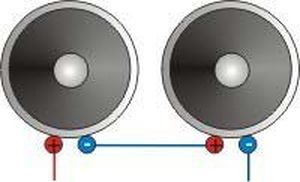4. Making Connections
There are three ways to connect loudspeakers: in parallel, that is each speaker receiving a direct signal from the amp; in series, or one after the other in a single (electrical) line from the amp; and in combinations of series and parallel connection. In some instances, speakers are connected via a crossover which distributes frequencies between the speakers, in which case the characteristics of the crossover will apply.
In guitar speaker cabinets or combo units, the speakers will be wired to match the specification of the amplifier, whether it is built-in or external.
The key consideration is the impedance, or resistance. Its like the narrowing of a stream of water - the narrower the gap, the more force is required to get the water through. In this instance, the higher the impedance, the more power you need to drive the speaker.
If the impedance of the speakers is higher than that of the amp, then you will get less than optimum performance from the speakers. If its less, then you risk damaging the speakers.

Parallel connection

Series connection
Combined series and parallel
The following table shows impedance values for various combinations of speaker connections:
Speaker
Combination | Individual
Impedance | Circuit | Total Impedance |
| 4x 12" | 4 Ohms | 2 x 2 LS in series,
2 Pairs parallel | 4 Ohms |
| 4x 12" | 4 Ohms | 2 x 2 LS in series,
2 Pairs series | 16 Ohms |
| 4x 12" | 8 Ohms | 2 x 2 LS in series,
2 Pairs parallel | 8 Ohms |
| 4x 12" | 8 Ohms | 2 x 2 LS in series,
2 Pairs series | 32 Ohms |
| 4x 12" | 16 Ohms | 2 x 2 LS in series,
2 Pairs parallel | 16 Ohms |
| 4x 12" | 16 Ohms | 2 x 2 LS parallel,
2 Pairs parallel | 4 Ohms |
| 2x 12" | 4 Ohms | Series | 8 Ohms |
| 2x 12" | 4 Ohms | parallel | 2 Ohms |
| 2x 12" | 8 Ohms | Series | 16 Ohms |
| 2x 12" | 8 Ohms | parallel | 4 Ohms |
| 2x 12" | 16 Ohms | Series | 32 Ohms |
| 2x 12" | 16 Ohms | parallel | 8 Ohms |
In this instance, the speaker size is given for reference only - its the impedances that count. Electrical impedance is independent of speaker size.
The most common individual speaker impedance is 8 Ohms, and where speakers are combined in cabinets, they are often wired to produce a total impedance of 8 Ohms. There is usually a plate on the cabinet stating the technical specification.
Cabinets will also often have a socket for the connection of another set of speakers, which is generally wired in parallel. If you add another 8 Ohm cabinet, the total impedance drops to 4 Ohms.





